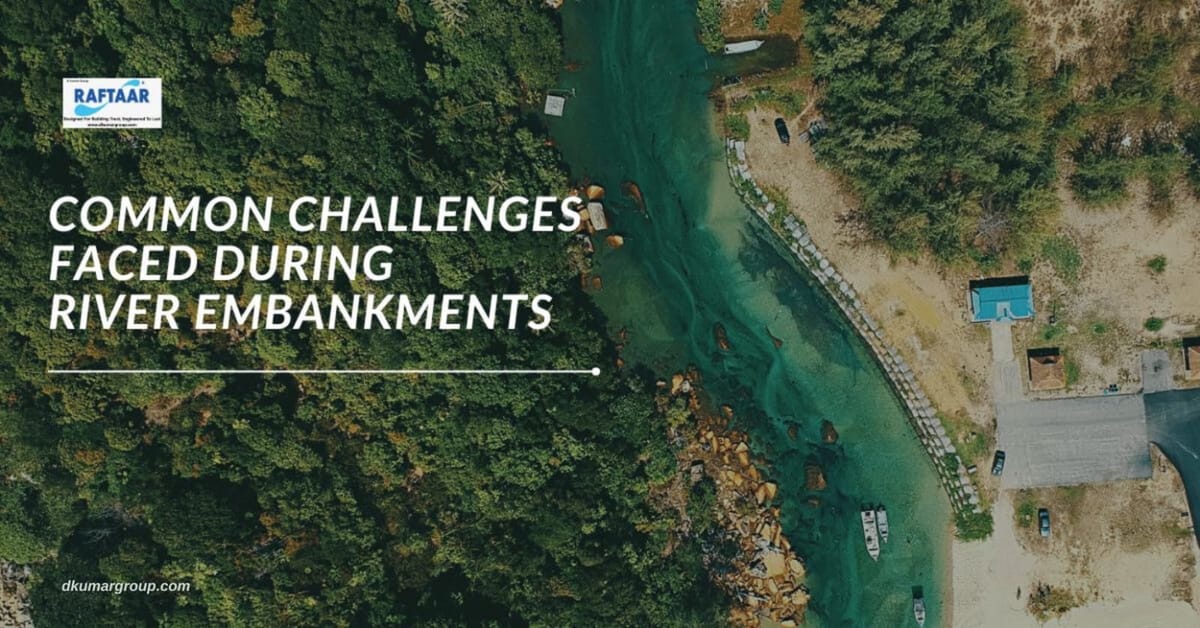Common Challenges Faced During River Embankments

Have you ever wondered why some areas are more prone to flooding than others? Well, the reason behind this includes multiple factors such as geographical location, topography, and hydrological conditions.
Floods hold the capacity to cause significant damage to property and infrastructure, leaving communities affected for months.
As per the ASDMA data, 160 human deaths were reported in 2017, 122 in 2020, and 102 in 2019. The 2024 floods affected 2.45 million people across 30 districts, with 52 flood-related deaths.
Such devastating consequences of floods, create a sense of concern and highlight the urgency for effective flood protection measures.
One such measure includes the construction of river embankments. Embankments are the structures designed to mitigate the risks and safeguard communities from the destructive force of floodwaters.
In this blog, we will explore different types of river embankments, their purposes, and the common challenges faced during their construction and maintenance.
What are River Embankments?
River embankments are the structures that help to protect the communities from the devastating impact of flood. These structures are typically constructed along the river banks and act as barriers, preventing the overflowing of the river waters.
This serves as a first line of defense against floods, reducing the initial risk of rising water levels. They help in regulating the water flow by preventing erosion and sedimentation.
If river embankments are built right along the river banks, they can help immensely in reducing flood damage to infrastructure and agricultural land, and protecting human lives.
Marginal Embankments: A First Line of Defense
Marginal embankments are constructed along the river banks to provide immediate protection against floodwater. Their primary purpose is to contain the river water within a designated bank or channel, even during high water levels.
Marginal embankments act as a physical barrier by limiting the extent of flood and safeguarding the nearby communities and infrastructure.
Key Features of Marginal Embankments
- Stone Protection
Stone protection involves covering the embankment’s slope with a layer of large stones. The size and type of stones used for this depends on the specific site conditions and severity of actions around the specific area.
This layer of stones helps in scattering the wave energy which reduces the erosion and maintains the embankment’s structural integrity.
- Freeboard
The freeboard is the vertical distance between the design high-water level and the top of the embankment. It acts as a safety margin and allows for fluctuations in water level and wave action.
- Core
The core of an embankment provides water tightness and structural stability. It is made of compacted clay or other such impermeable material, which doesn’t allow the water to pass through.
The core of the embankment helps prevent water seepage in the embankment and ensures its effectiveness in containing floodwaters.
- Filter Layer
The filter layer is placed between the core and outer shell of the embankment. As the name suggests, the filter layer acts as a filter for the embankment and prevents the migration of fine soil particles from the core into the outer shell.
- Outer Shell
The outer shell of an embankment protects against erosion and weathering. It is usually more durable and resistant to the forces of water and wind.
Retired Embankments: A Secondary Layer of Protection
Unlike marginal embankments, retired embankments are built further away from the river banks and serve as an intermediate solution to control floodwaters. These embankments provide a secondary layer of protection against flooding and help in the following ways:
- Physical Barrier: If a marginal embankment fails or is overstopped, retired embankments act as a secondary barrier, by slowing down the spread of flooding and reducing their impact on downstream areas.
- Reduce Flood Depth: By reducing the volume of water to reach a specific area, retired embankments help in reducing flood depths and minimizing damage.
- Erosion Control: Retired embankments help in reducing erosion and stabilizing riverbanks, leading to the protection of valuable land and ecosystem.
Challenges Faced During River Embankment Construction and Maintenance
The construction and maintenance of river embankments are complex processes that include multiple challenges, such as
Hydrological and Hydraulic Challenges
- Inaccurate Hydrological Data: Inaccurate hydrological data can lead to miscalculations in designing the embankments which can further affect their effectiveness and structural integrity.
- Extreme Weather Conditions: Weather conditions, such as storms or heavy rainfall can significantly affect the embankments, leading to breaches or erosion.
- River Morphology Changes: Changes in the shape of river channels can affect the performance and stability of the embankments.
Construction Challenges
- Material Availability and Quality: Ensuring the availability and quality of necessary materials can be extremely challenging, especially in remote areas.
- Equipment and Labor Shortage: Finding the right equipments and skilled laborers can be difficult in certain regions, leading to delays in the project timelines and increased costs.
Geotechnical Challenges
- Foundation Conditions: Weak foundation conditions can lead to the failure of the embankments.
- Soil Variability: Variations in soil properties, such as permeability and shear strength, and high groundwater levels can impact the structure and stability of the embankments.
Maintenance Challenges
- Erosion and Sedimentation: Continuous erosion and sedimentation can degrade soil quality. This can affect the integrity of embankments, leading to regular maintenance and repair costs.
- Vegetation Growth: Uncontrolled vegetation growth can weaken the foundation of the embankments and hinder drainage.
Conclusion
River embankments are essential infrastructure for protecting communities from the devastating impacts of floods.
By understanding the major types of embankments and the challenges associated with their construction and maintenance, you can understand their role better in safeguarding multiple lives and property.
To ensure the effectiveness of river embankments, it is highly crucial to address the common challenges through proper planning, designing, construction, and maintenance. This will further help in building safer and more sustainable communities.
Want to know more about effective flood management and resilient infrastructure for a safer tomorrow? Visit our website today to learn more about flood management solutions and their effectiveness.




